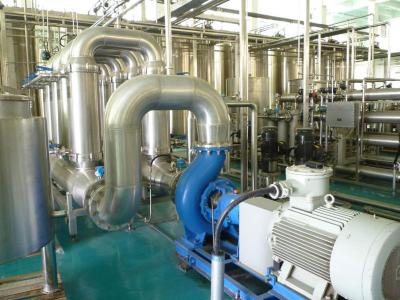From clothes to high buildings, low-carbon olefins are indispensable in all aspects of life. Especially ethylene and propylene, play an important role in modern petroleum and chemical industry as basic organic chemical raw materials.
MTO/DMTO technology can replace naphtha cracking technology to produce low-carbon olefins, which can save crude oil and naphtha resources, and alleviate the contradiction between oil and olefin resources shortage.
MTO/DMTO is a chemical technology which uses methanol as raw material and dehydrates methanol to produce low-carbon olefins in the reactor. During MTO/DMTO reaction, the main products are low-carbon olefins, and a large number of by-products such as water, mixed alkanes, olefins, aromatics and yellow-brown oily liquids are also produced. When water is used as absorbent to absorb light hydrocarbons such as methanol, dimethyl ether and other heavy hydrocarbons, light hydrocarbons, such as methanol and dimethyl ether, are put forward by steam and reacted in a back-and-forth reactor. Some heavy hydrocarbons in water, such as emulsified paraffin and yellow-brown oily liquids, will be continuously enriched in circulating water. After heat transfer by heat exchanger, the water temperature will drop, and the emulsified oil in water will be absorbed in the heat exchanger. It leads to the decrease of heat transfer effect, even blockage of heat exchanger, seriously affecting the stable operation of the system.
In the process of MTO/MTP reaction, the recycling of quench water in the quench tower will lead to the enrichment of catalyst and a small amount of oil in the reactor. The catalyst acts as a bridge to form large particulate matter, wear and blockage of air holes, resulting in the paralysis of the water treatment system.
Therefore, in view of the two phenomena mentioned above, Jiangsu Jiuwu Hi-tech Co., LTD develops an inorganic membrane separation technology to purify quench water and wash water, which effectively solved the blockage problem of catalyst and emulsified oil in water system equipment.
Overview of Technology
The process uses cross-flow filtration technology of inorganic ceramic membrane to remove catalyst and emulsified oil impurities from quench water and washing water efficiently. The raw materials of quench water and washing water are fed into the circulating pump by the feeding pump and then they are fed into the inorganic ceramic membrane filter. The feed liquid flows at high speed in the flow channel of the membrane tube. The catalyst and emulsified oil are intercepted by the ceramic membrane in the concentrated liquid. The clarified osmotic fluid is driven by pressure and enters the MTO water circulation system for reuse. The concentrate containing catalyst is centrifugally separated and filtered by plate-frame pressure. The filtrate is re-entered into the inorganic membrane system for recovery. Oily concentrate is fed into the system to incinerate and recover chemical energy by utilizing its high calorific value. Inorganic ceramic membrane filtration has high separation accuracy and good water quality. It thoroughly solves the influence of impurities in quench water and washing water on MTO water system equipment, avoids blockage of trays, heat exchangers and air coolers, greatly prolongs equipment operation time, reduces equipment cleaning frequency and improves system stability.
Technological characteristics
1.
High separation accuracy and complete removal of impurities. It uses high precision filter ceramic membrane, which can completely remove catalyst powder and emulsified oil from quench water and wash water. The separation efficiency of catalyst is more than 99%, and that of oil over C5 is more than 99%.
2.
The process is simple. The inorganic membrane separation system does not need complex pretreatment and has simple process. It can realize the automatic control of PLC. It has low labor intensity and saves manpower cost.
3.
There is no need to use expensive demulsifier and flocculant, and the operation cost is low.
4.
It is cross-flow filtration, pollution-resistant, and can maintain high-throughput filtration.
5.
The regeneration effect is good. After membrane fouling, the recovery rate of membrane flux was over 99% by alkali washing and acid washing.
Technical Advantage
Water production advantage
Because the catalyst particle size is very small, 80% of it is below 10 um, the separation efficiency of conventional cyclone separator is poor, even if it is a high-efficiency micro-cyclone separator, the separation efficiency is not more than 90%, and the content of water-producing catalyst is about 30 ppm. The separation accuracy of ceramic membrane is higher than 200 nm, the separation efficiency of emulsified oil particles from catalyst granules is more than 99%, and the content of water-producing catalyst and emulsified oil is less than 5 ppm.
Cost advantage
Taking the MTO unit of Shenhua Coal Chemical Branch as an example, after entering the commercial operation stage in 2011, the unit needs to be cleaned three times a week due to the blockage of heat exchangers, each cleaning cost is about 20,000 yuan, and the annual cleaning cost is about 3 million yuan. During this period, the product gas is used to set off torches and methanol consumption is more than 3 million yuan; the problem of tray blockage is solved by injecting xylene, and the annual consumption of xylene is over 1 million yuan; in addition, the energy consumption is greatly increased due to system blockage. If the ceramic membrane separation technology is used, the problem of catalyst and emulsified oil entrained in quench water and washing water can be solved, and the annual operation cost can be saved by more than 7 million yuan.




 +86-25-58849045
+86-25-58849045
 +86-25-58749295
+86-25-58749295
 jiuwu@jiuwu.com
jiuwu@jiuwu.com
 No. 9 Park Road, Pukou District, Nanjing City (Sanqiao Factory)
No. 9 Park Road, Pukou District, Nanjing City (Sanqiao Factory) Call us on:
Call us on:  Email Us:
Email Us:  No. 9 Park Road, Pukou District, Nanjing City (Sanqiao Factory)
No. 9 Park Road, Pukou District, Nanjing City (Sanqiao Factory)

 English
English 한국어
한국어 français
français русский
русский Español
Español

